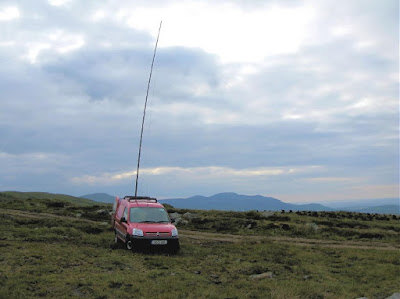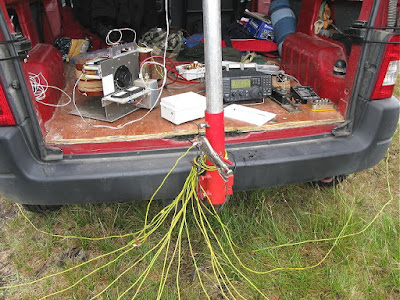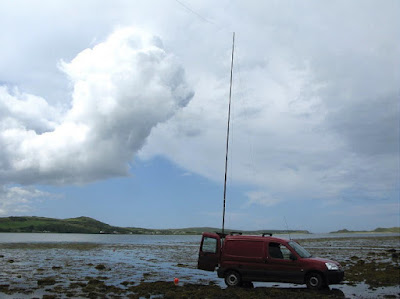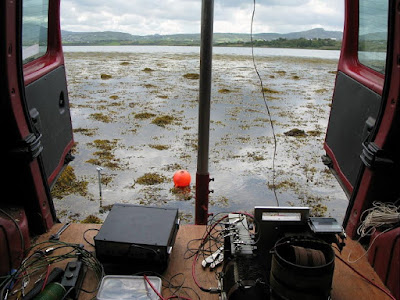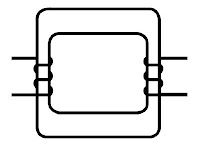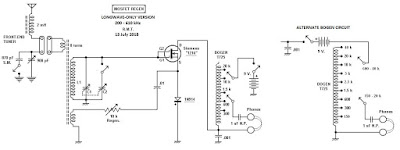Author Archive
 Hunting For NDBs in CLE 236
Hunting For NDBs in CLE 236
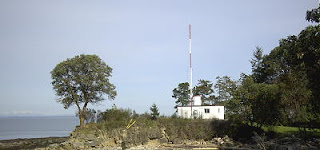 |
| AP-378 Mayne Island, BC |
How time flies. Once again it's a CLE weekend. It seems like the last one was just a week ago!
'CLE's are 'Co-ordinated Listening Events, and NDB DXers around the world focus their listening time on one small slice of the NDB spectrum.
This time the hunting ground is the 15 kHz slice from 370.0 - 384.9 kHz.
This is a somewhat dreaded range for me since my local blowtorch NDB, 'AP' (378 kHz), sits right in the middle of the range. 'AP' is located at the entrance to Active Pass, the main ferry route to Vancouver Island, and the antenna is about 3/4 of a mile down the beach from me. Needless to say, the beacon is about 40db over S9! With careful loop nulling, I can reduce this by about 25db but it's still an enormous signal to deal with.
Hopefully you can put 'AP' in your own log this weekend but its 25-watt signal will be much weaker for you. It's been logged as far east as Illinois and with your receiver in the CW mode, can be found on 378.399 kHz.
All too often our CLE weekends get hammered by geomagnetic disturbances, possibly because our monthly schedule syncs up nicely with the Sun's rotation and the disturbance from the previous month once again rotates into position. Conditions this time surely can't be much worse than for our previous event and today's mid-week check looks promising.
 |
| courtesy: NOAA |
 |
| courtesy: NOAA |
Things seem geomagnetically quiet at the moment so lets hope they stay that way. LF and MF propagation can often be amazing in the fall and as summer storms start to dissipate, the band can become much less noisy.
From CLE coordinator Brian Keyte (G3SIA), comes the following CLE info:
Hi all,
Please join us in our 236th coordinated Listening Event which starts
this Friday and celebrates the arrival of the Equinox this weekend.
CLEs are not contests - if you enjoy taking part you will be a winner!
Days: Friday 21 September - Monday 24 September
Times: Start and end at midday, LOCAL TIME at the receiver
Range: 370 - 384.9 kHz
Just log all the NDBs that you can identify with their nominal (listed)
frequencies in the range (it includes 370 kHz, but not 385 kHz)
plus any UNIDs that you come across there.
Please send your CLE log to the List in a plain text email if possible
(not in an attachment) with CLE236 and FINAL at the start of its title.
Show on each log line:
# The date (e.g. 2018-09-21, etc., or just 21) and UTC
(the date changes at 00:00 UTC)
# kHz (the nominal published frequency, if known)
# The Call Ident.
Show those main items FIRST - other optional details such as Location
and Distance go LATER in the same line.
If you send interim logs, please also send a 'FINAL' (complete) log.
As always, tell us your own location and brief details of the equipment
that you were using during the weekend.
Joachim or I will send the usual 'Any More Logs?' email at about 17:00
UTC on Tuesday - you can then check that your log has been found OK.
All logs must arrive on the list at the very latest by 08:00 UTC on
Wednesday 26th September. We hope to complete making the combined
results within a day or two.
To help you to plan your listening, seeklists and maps for your part of the
World are available via the CLE page http://www.ndblist.info/cle.htm
Good listening - enjoy the CLE.
Brian
------------------------------------------------------------------
From: Brian Keyte G3SIA ndbcle'at'gmail.com
Location: Surrey, SE England (CLE coordinator)
------------------------------------------------------------------
If you are interested in some remote listening - maybe due to local difficulties - you could use any one remote receiver for your loggings, stating its location and with the owner’s permission if required. A remote listener may NOT also use another receiver, local or remote, to make further loggings for the same CLE.
-------------------------------------------------------------------
These listening events serve several purposes. They:
The Yahoo ndblist Group has been moved to Groups.io and The NDB List Group will now be found there! The very active group is a great place to learn more about the 'Art of NDB DXing' or to meet other listeners in your region. There is a lot of good information available there and new members are always very welcome. As well, you can follow the results of other CLE participants from night to night as propagation is always an active topic of discussion.
You need not be an NDB List member to participate in the CLEs and all reports, no matter how small, are of much value to the organizers.
Remember - 'First-time' logs are always VERY welcome!
Reports may be sent to the NDB List Group or e-mailed to CLE co-ordinator, Brian Keyte (G3SIA), whose address appears above. If you are a member of the group, all final results will also be e-mailed and posted there.
Please ... give the CLE a try ... then let us know what NDB's can be heard from your location! Your report can then be added to the worldwide database to help keep it up-to-date.
Have fun and good hunting!
- determine, worldwide, which beacons are actually in service and on-the-air so the online database can be kept up-to-date
- determine, worldwide, which beacons are out-of-service or have gone silent since the last CLE covering this range
- will indicate the state of propagation conditions at the various participant locations
- will give you an indication of how well your LF/MF receiving system is working
- give participants a fun yet challenging activity to keep their listening skills honed
The Yahoo ndblist Group has been moved to Groups.io and The NDB List Group will now be found there! The very active group is a great place to learn more about the 'Art of NDB DXing' or to meet other listeners in your region. There is a lot of good information available there and new members are always very welcome. As well, you can follow the results of other CLE participants from night to night as propagation is always an active topic of discussion.
You need not be an NDB List member to participate in the CLEs and all reports, no matter how small, are of much value to the organizers.
Remember - 'First-time' logs are always VERY welcome!
Reports may be sent to the NDB List Group or e-mailed to CLE co-ordinator, Brian Keyte (G3SIA), whose address appears above. If you are a member of the group, all final results will also be e-mailed and posted there.
Please ... give the CLE a try ... then let us know what NDB's can be heard from your location! Your report can then be added to the worldwide database to help keep it up-to-date.
Have fun and good hunting!
 The Fall “Classic Exchange”
The Fall “Classic Exchange”
 |
| W7OS - Radio Club of Tacoma working the CX |
The "CX" encourages participants to use older vintage gear including any homebrew equipment, both receivers and transmitters. A unique scoring system provides bonus points for various equipment and combinations as well as encouraging 'repeat contacts' when you switch to different equipment.
 |
| W8KM and his wonderful vintage station |
No vintage gear? ... no problem! All amateurs are invited to participate and get in on the fun no matter what they are using and submit their scores.
 |
| K3MD's Heathkit AT-1 and Hallicrafters HT-37 ready for the CX |
The CX is a low-key relaxing affair and the 'extra' Tuesday operating period should encourage a lot of midweek activity from the vast numbers of retired operators who cherish and run older gear.
 | ||||||||||||||||||||||||
| Lots of combos ready at W4BOH's CX setup |
 |
| K6ZI, Las Vegas - WWII ARC-5s ready to go |
For complete details, see the web site announcement here.
If you've never entered the Classic Exchange, why not give it a try this year as it truly is a case of 'the more the merrier' ... and eastern operators, make sure to keep the porch light on for us out west!
 The 630m Portable Adventures of EIØCF
The 630m Portable Adventures of EIØCF

In the years before amateurs in the UK had access to the 630m band as we know it today (472-479kHz), hams there could apply for a 'special research permit' allowing them to operate between 501 and 504kHz.
One of the first and most active stations was operated by Finbar O'Connor, EIØCF, located in the most northern part of Ireland, near Malin Head. In the early days, Finbar might as well have been AC4YN in Lhasa, Tibet, as a 630m or a 2200m QSO with EIØCF was a much prized DX trophy and a genuine 'right of passage' for many little backyard LF and MF stations throughout Europe.
Nowadays, 630m activity in Europe is not as robust as it once was but Finbar is still active on MF from his modest station. He reports being copied in North America on several occasions. Although mainly active in the WSPR mode, Finbar is now considering the two-way JT9 weak signal QSO mode and may hopefully once again, tease east coast North American MF operators with a new rare entity from his seaside location.
 |
| Finbar's WSPRlite setup for 630m |
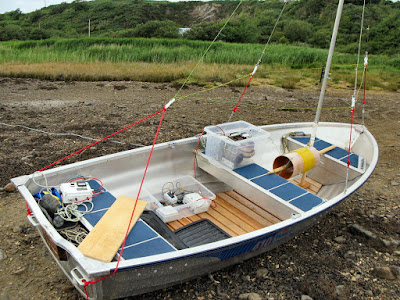 |
| EI0CF/marine on 630m! |
What follows is a delightful adventure, in Finbar's own words, describing some of his field trips back in the 500kHz experimental days ... perhaps it will inspire some North American portable work or provide ideas for an emergency prep 630m grab-and-go kit, or just get you excited about our newest amateur allocation.
******************
Operating Portable on 501 - 504 khz Medium Wave
Operations on the north flank of Slieve Snacht Inishowen Peninsula.
In June 2009 Ireland joined a growing number of countries permitted to operate on a small portion of the medium wave band, just below the commercial broadcast segment, in the range 501 - 504 khz. Several stations were granted permission and operations commenced. As has been documented elsewhere many stations have been worked, both in band and cross band, at home and abroad, ranging from Continental Europe, across the Atlantic to the USA and Canada, down to the southern end of Ukraine and finally up to Iceland, Norway, Sweden, Finland and also being heard in Moscow.
A notable feature of this band is the steady reliable nature of groundwave coverage and with this in mind I recently availed of the facility whereby portable operations can take place. Comreg, together with the IRTS and the individual involved, require that each event is applied for, giving relevant dates, location, contact details, hours of operation and the power of the transmitter being used.
In the period leading up to all this it was necessary to build and test a viable portable station based on the use of my Berlingo van. A 30' part of a 40' Spiderbeam fibreglass pole was used with a simple round wooden peg to secure the 'Tee' wire antenna, which was fabricated from twin twisted multistrand speaker wire. The vertical used both, while the rest was pulled apart to form the two horizontal legs.
A 100 metre roll of 1.5 mm insulated earthing wire was cut into 16 lengths to provide radial wires, with lugs soldered to one end and a bonding bolt used to secure a single point for the radial kit. The far ends formed a small loop which was sealed and secured with insulating tape. The loop provided an eye for a small L shaped stiff wire, fashioned from discarded coat hangers, an ideal and cheap way to hold the ends of the radial wires in place in the ground.
To secure the antenna support to the van, I refer you to the excellent idea described by John EI7BA, on his web page, for a ball hitch connection:
http://www.qsl.net/ei7ba/a_ball_hitch_mobile_mount.htm
Using this superb idea, I got the welder out and made one for myself. It worked perfectly.
I now had the support and wire antenna, with a ballpark figure for what might resonate, along with the radial kit. I next needed a dedicated antenna tuning unit. An old variometer and two extra fixed multitap coils were selected. A home made 1 amp ammeter and SWR twin meter unit completed the fit-out. These were all assembled on a base with a handle on the top, making it easy to move around whilst out and about.
The main antenna for 500kHz was disconnected and left floating and the van set up with all this gear, but no transmitter. Instead, my little antenna bridge running off a 9-volt battery provided the necessary signal to start testing for basic resonance.
Whether from sheer good luck or some sub-conscious input, resonance fell within the range of the variometer with only one of the two extra coils in circuit. The relative height and length also play a part in the range of resonance secured. Matching to 50 ohms was then optimized by selecting 4700 pf Mica capacitors using Croc Clip links. The available value ranged from 1 nF to 14 nF.
I have a selection of 500khz transmitters, two of which are to the design of Roger, GW3UEP, who lives 10 miles inland from the coast, in south Wales. His 500khz web site is well worth checking out, containing plans for versions of his 500khz transmitters, test equipment pictures and recordings of 500khz activities.
http://www.gw3uep.ukfsn.org/
One of these was used to put some RF into this first portable style installation, and by arrangement, Roger listened and heard my signal. We delightedly completed a short contact, with my transmitter running just 10 watts.Things were looking good.
One of the very valuable things about portable operations stems from the need to bring together several elements to secure a working radio station, without the usual backup we enjoy from home. Planning is essential. Doing a dry run, i.e. actually physically building the intended station then notating all the gear required and making a list as well as providing backup items, particularly those that which if broken or lost, would render the whole radio station non-viable. This also extends to the operator of the equipment. Will they be warm or cool enough, have shade, food, water and enough needed rest? Always be prepared to abandon the project if safety is compromised, for whatever reason.
Now that I had a viable portable station for 500kHz working, it was time to head off and test both the equipment and myself in the real world, but without any live transmissions taking place.
Several sites were chosen and tested, with particular emphasis placed on remoteness, i.e. high up on mountains or near the sea. All sites worked very well, but those by the sea proved really excellent. Reception of NDB’s (Non Directional Beacons) provided a ready supply of medium to low frequency signals for range testing. I was now itching to “ have a go “ out in the wilds, on 500kHz! Using the method required by Comreg, an application was made for several sites, on specific days.
In early June I loaded up the van with all the gear and headed off for the mountain above Redcastle, County Donegal. Using a narrow track and climbing higher, to about 270 meters, a place was found leading to an old quarry. Typically, it had started to rain. By the time I had erected the support pole, pulled out and secured the top hat wires using light nylon line and deployed the radial wires around and below the vertical drop wire, my trouser ends were very wet!
Plugging in the 12-volt supply, the receiver was very quickly perked up, using the variometer. The Morse key connected to the QTX transmitter and the transmit / receiver switch flicked over. Time to get some RF flowing in the antenna. Sure enough, on key down, the antenna current meter shot right up to 400 mA, but the SWR match was not exactly perfect. Time to work those Croc Clips and start selecting shunt capacitors to find the perfect match. Soon I had that sorted to my satisfaction, with antenna current now up to 550 mA. A quick return to receive showed that Roger, GW3UEP was already tuned up on frequency.
"..... GW3UEP DE EIØCF/P HW K"
He came back straight away! Oh joy, we were on the air on 500, in a remote mountain area, the top of my antenna almost tipping the clouds as they swept past. I was open to the elements, standing at the back door of the van with the tips of my fingers reaching for the knob of my very favourite old Amplidan morse key, snug beside the other bits and pieces of equipment on the van floor!
My logbook, with its pages flapping back and forward in the wind, soon had the first 500kHz portable contact documented. A full hour later, solid steady signals continued at a distance of 250 miles. Proving just how good groundwave signals can be, I terminated communications from the remote portable location, happy with the results. Within 12 minutes I had dismantled the station and was on my way to Moville, along with a strong cup of coffee at the café on the town's main street.
Several other portable operations have since taken place. A number have also occurred at my home location. We live right beside the sea; high tides lap up on to the salt marsh, which is part of the property.
Driving a single earth rod into the sea shore to a depth of 1 metre, with no radials and just a single wire between the rod and the ATU earth, the 1 amp RF meter had its meter needle slamming against the end stop. Lots of antenna current for 15 watts transmitter output power. Those same 15 watts only providing, at best, 550 mA, whilst up on the mountain sites.
Finally, it was thought productive to try a kite-supported antenna from the seashore portable set up. Winds on the day selected seemed strong enough to enable my Delta shape kite to head aloft with a flying line and antenna wire attached. The Berlingo van was driven down on shore, everything connected and tuned up. All was well, or was it?
The receiver now seemed quite dead with no band noise and no antenna current on transmit. Looking skywards I could see nothing. My eye followed the antenna wire heading for deeper water. Then I saw it. The kite had plunged into the sea! The following 30 minutes entailed untangling loads of seaweed with the line wrapped around rocks, barnacles and everything imaginable. What a mess! I almost gave up, but knew that Roger would be coming up on frequency, on sked, in about 15 minutes.
Eventually I managed to get the kite skywards again but by now the wind was acting more unpredictably. I established contact with Roger and he immediately gave me an S 7 report for my 15 watts. This equated to the report I would get from my main station antenna running 100 watts. My single ground rod and 150 feet of wire were doing the business.
We carried on our contact, but what remained became a battle of wits, with a kite constantly diving down and soaring up again. Several times the antenna wire was in part lying on the sea shore and antenna current way down to 200 mA or lower. My left hand was on the variometer tuning knob, tweaking the setting as best as possible, while pulling in the slack to keep the antenna wire off the ground. Feeding the wire out again to a misbehaving kite, I kept keying away with my right hand, keeping Roger updated so he could understand why my signal was changing both in pitch (sudden antenna mis-match conditions) and signal strength.
Luckily he was also making a recording, which proved later to be a fascinating record of a difficult portable antenna and station operation. It’s remarkable how tolerant, despite the wildly changing antenna conditions, the system actually was in practice. Communications were maintained despite all these negative factors and severely decreased radiated power at times.
Several other tests were conducted within these experiments which would have been almost impossible to conduct without the challenges thrown up by my portable operations. To my mind the 501 – 504khz band exhibits a distinct advantage for enhanced groundwave coverage over that available to higher frequencies.
Relatively simple equipment deployed in remote locations, with or without the availability of the power grid, would provide a solid backbone link or network in times of emergency. Transmitter power output was kept deliberately low to ensure that a higher ERP would not mask any possible weakness in the system. I am happy to conclude that Medium Frequency CW proved it’s worth once again.
Already I have further plans to test smaller, more compact portable antenna and earthing systems in more remote locations.
Finbar O’Connor EIØCF Malin, County Donegal.
 CLE 235 Results
CLE 235 Results
 |
| BF-362 Seattle |
As it turned out, summer lightning noise was the least of CLE 235's problems!
The weekend event saw its all too often 'solar hit' shortly after the start of the event, with Friday evening being the only night (in North America anyway) that had propagation. Saturday and Sunday nights were almost complete blackouts, with just one catch recorded on each night.
With the K-index soring to at least 7, there was really not much to be heard after Friday night save for a very robust appearance from RG-352 at the Rarotonga International Airport, just before dawn on Sunday morning. Thanks to Dan, VE7DES, listening from the club station at UBC, for the tip!Disturbed conditions often seem to enhance the Pacific path but other than Hawaii, this was the only other signal heard from the west. Sunday morning found DPY-365 in Washington state. Up until that time, its signal had been completely missing-in-action ... but it was loud at 0100 local. Perhaps it had been down for maintenance and not on the air until Sunday.
 |
| courtesy: NOAA |
My log consisted of 30 stations, with all but two from Friday night before the storm. As usual, the receiver was a Perseus SDR and an 'Inverted-L', resonated at 300 kHz.
25 07:00 350 VTR McGrath, ALS
25 12:00 350 SWU Idaho Falls, ID, USA25 08:00 350 RG Oklahoma City, OK, USA
25 07:00 350 NY Enderby, BC, CAN
25 07:00 351 YKQ Waskaganish, QC, CAN
26 12:00 352 RG Rarotonga IAP, CKS
25 07:00 353 ZXY Whitehorse, YT, CAN
25 08:00 353 PG Portage La Prairie, MB, CAN
25 13:00 353 LLD Lanai Island, HWA
25 07:00 353 AL Dixie, WA, USA
25 12:00 355 AUB King Salmon, ALS
25 12:00 356 ZXE Saskatoon, SK, CAN
25 08:00 356 ZF Yellowknife, NT, CAN
25 08:00 356 PND Portland, OR, USA
25 08:00 356 ON Penticton, BC, CAN
25 12:00 356 MEF Medford, OR, USA
25 09:00 358 SIT Sitka, ALS
25 09:00 359 YQZ Quesnel, BC, CAN
25 09:00 359 YAZ Tofino, BC, CAN
25 07:00 361 HI Holman, NT, CAN
25 07:00 361 E3 Wabasca, AB, CAN
25 07:00 362 YZS Coral Harbour, NU, CAN
25 07:00 362 RPX Roundup, MT, USA
25 07:00 362 BF Seattle, WA, USA
25 08:00 362 6T Foremost, AB, CAN
25 07:00 365 YGZ Grise Fiord, NU, CAN
25 12:00 365 MA Mayo, YT, CAN
27 08:00 365 DPY Deer Park, WA, USA
25 07:00 365 AA Harwood, MN, USA
25 12:00 368 ZP Sandspit, BC, CAN
25 12:00 368 VX Dafoe, SK, CAN
The results from ALL participants may be viewed here.
 Hunting For NDBs In CLE 235
Hunting For NDBs In CLE 235
 |
| BF-362 courtesy: Steven M O'Kelley |
This coming weekend will see another monthly CLE challenge. This time the hunting grounds will be 350.0 - 369.9 kHz.
For those unfamiliar with this monthly activity, a 'CLE' is a 'Co-ordinated Listening Event', as NDB DXers around the world focus their listening time on one small slice of the NDB spectrum.
A really good challenge in this one is to hear BF-362, located in Seattle, Washington. I suspect that it's a 25-watter but is rarely logged outside of the Pacific Northwest region. If you are east of Montana and can hear it, your system is working well!
Listen for BF's upper-sideband CW identifier (with your receiver in the CW mode) on 363.030 kHz while its lower-sideband can be heard on 360.943 kHz.
Although we are getting ever-closer to the fall DX season, lightning storms may yet be a problem, but at this time of the year we may get a lucky few quiet nights like this one in mid-June.
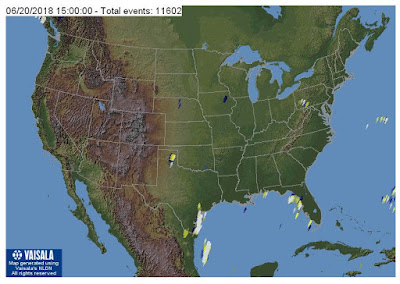 |
| courtesy: http://thunderstorm.vaisala.com/explorer.html |
If you are interested in building a system for the new (U.S.) 630m band, the CLE will give you the chance to test out your MF receiving capabilities and compare against what others in your area might be hearing.
When tuning for NDBs, put your receiver in the CW mode and listen for the NDB's CW identifier, repeated every few seconds. Listen for U.S. NDB identifiers approximately 1 kHz higher or lower than the published transmitted frequency since these beacons are modulated with a 1020 Hz tone approximately.
For example, 'AA' near Fargo, ND, transmits on 365 kHz and its upper sideband CW identifier is tuned at 366.025 kHz while its lower sideband CW ident can be tuned at 363.946 kHz. Its USB tone is actually 1025 Hz while its LSB tone is 1054 Hz.
Often, one sideband will be much stronger than the other so if you don't hear the first one, try listening on the other sideband.
Canadian NDBs normally have an USB tone only, usually very close to 400 Hz. They also have a long dash (keydown) following the CW identifier.
All NDBs heard in North America will be listed in the RNA database (updated daily) while those heard in Europe may be found in the REU database. Beacons heard outside of these regions will be found in the RWW database.
From CLE organizer Brian Keyte, G3SIA, comes the details:
Hello all
Here are the full details for this weekend's co-ordinated listening event.
It is open to everyone including CLE new-comers:
Days: Friday 24 August - Monday 27 August
Times: Start and end at midday, your LOCAL time
Range: 350.0 - 369.9 kHz
This range is a busy one, usually giving us a high number of NDBs heard.
We last concentrated on these frequencies during CLE219 in May 2017.
Wherever you are, please join us and log the NDBs that you can positively
identify that are listed in this busy frequency range (it includes 350.0 kHz
but not 370 kHz) plus any UNIDs that you come across there.
Send your CLE log to the List, preferably as a plain text email
(not in an attachment) with "CLE235 - FINAL Logs" at the start of its
subject line.
Please show on EVERY LINE of your log:
# The date ( e.g. 2018-08-24 or just the day no. 24 ) and UTC
(the day changes at 00:00 UTC).
# kHz (the beacon's nominal published frequency, if you know it)
# The Call Ident.
Show those main items FIRST on each line, before other optional details
such as Location, Distance, Offsets, Cycle time, etc.
If you send any incomplete logs to the List during the event, please also
send your 'FINAL', complete one.
Please always make your log interesting to everyone by showing your
own location and brief details of the receiver and aerial(s), etc., that
you were using.
We will send the usual 'Any More Logs?' email so that you can check that your log has been found OK.
You can check on all CLE-related information from the CLE Page
http://www.ndblist.info/cle.htm
It includes a link to seeklists for the Event from the Rxx Database.
Good listening
Brian
----------------------------------------------------------
From: Brian Keyte G3SIA ndbcle'at'gmail.com
Location: Surrey, SE England (CLE coordinator)
----------------------------------------------------------
(REMINDER: You could use any one remote receiver for your loggings,
stating the location and owner - with their permission if required.
A remote listener may NOT also use another receiver, whether local
or remote, to obtain further loggings for the same CLE).
-------------------------------------------------------------------
These listening events serve several purposes. They:
The Yahoo ndblist Group has been moved to Groups.io and The NDB List Group will now be found there! The very active group is a great place to learn more about the 'Art of NDB DXing' or to meet other listeners in your region. There is a lot of good information available there and new members are always very welcome. As well, you can follow the results of other CLE participants from night to night as propagation is always an active topic of discussion.
You need not be an NDB List member to participate in the CLEs and all reports, no matter how small, are of much value to the organizers.
Remember - 'First-time' logs are always VERY welcome!
Reports may be sent to the NDB List Group or e-mailed to CLE co-ordinator, Brian Keyte (G3SIA), whose address appears above. If you are a member of the group, all final results will also be e-mailed and posted there.
Please ... give the CLE a try ... then let us know what NDB's can be heard from your location! Your report can then be added to the worldwide database to help keep it up-to-date.
Have fun and good hunting!
- determine, worldwide, which beacons are actually in service and on-the-air so the online database can be kept up-to-date
- determine, worldwide, which beacons are out-of-service or have gone silent since the last CLE covering this range
- will indicate the state of propagation conditions at the various participant locations
- will give you an indication of how well your LF/MF receiving system is working
- give participants a fun yet challenging activity to keep their listening skills honed
The Yahoo ndblist Group has been moved to Groups.io and The NDB List Group will now be found there! The very active group is a great place to learn more about the 'Art of NDB DXing' or to meet other listeners in your region. There is a lot of good information available there and new members are always very welcome. As well, you can follow the results of other CLE participants from night to night as propagation is always an active topic of discussion.
You need not be an NDB List member to participate in the CLEs and all reports, no matter how small, are of much value to the organizers.
Remember - 'First-time' logs are always VERY welcome!
Reports may be sent to the NDB List Group or e-mailed to CLE co-ordinator, Brian Keyte (G3SIA), whose address appears above. If you are a member of the group, all final results will also be e-mailed and posted there.
Please ... give the CLE a try ... then let us know what NDB's can be heard from your location! Your report can then be added to the worldwide database to help keep it up-to-date.
Have fun and good hunting!
 Recent Noise Mystery Solved
Recent Noise Mystery Solved
You may recall a recent blog regarding my installation of a new pair of inverted-V dipoles, fed from a common coaxial feedline at around 85'. Both antennas 'hear' very well and everything was peachy until I recently put the inverted-V's on my Perseus SDR.
I had been particularly interested in using the new high antennas for my general shortwave listening on 40m and below but what I observed was immediately troubling when listening on the 5 - 6MHz, 49m band. After much head-scratching about what I had noticed, I posted the following 'help' message to the Perseus reflector as well as to the Perseus SDR Facebook site:
Perhaps others can help explain something odd that I have just noticed with my Perseus while comparing antennas.
I was comparing signal levels and noise between a 40m half sloper and a very high dual 40/80m pair of inverted-V dipoles fed from a common feedline. Both the sloper and the dipoles are fed with 50 ohm cable and all three antennas are well matched at the low end of the band(s).
Listening to a 6 MHz signal from China National Radio around 10 am today, the signal was around S7-8 on the Perseus, using the 40m sloper. Listening to the same signal, at the same time, on the Yaesu FT-1000mp, with the high inverted-V, it was slightly better, maybe by 5-6 db and overall lower noise. I then put the inverted-V onto the Perseus and there was not even a trace of the signal! I made this check with several signals and always with the same result.
Now I suspect that the SWR of the 7MHz inverted-V when used at 6MHz, is very high and the load presented to the Perseus antenna input is likely highly reactive and far from 50 ohms but that doesn't seem to bother the FT-1000.
I then ran the inverted-V through my antenna tuner so that it effectively produced a 50 ohm non-reactive input load for the Perseus and did the tests again...with the same results. Swapping antennas for the 40m sloper once again produced the same signal levels in both the Perseus and the FT-1000.
So what is going on here and why does the Perseus balk at the 7 MHz inverted-V while listening on 6 MHz? Is there something in the Perseus front-end analog filtering system that is overly sensitive even though the reactance was tuned out via the tuner? Is it the 80m V on the same feedline as the 40m V that is causing some still unwanted reactance that is not tuned out with the tuner?
Any ideas what is happening here as it looks like I will not be able to use the inverted-V antennas on the Perseus for general SWL out-of-band listening for some, as yet unknown, reason.
As you can see, I was completely mystified by what I was hearing, or rather not hearing, and as it turned out, completely off the mark.
I received a few replies offering some possible reasons for what I was seeing but none of them proved helpful in solving my dilemma ... until Roelof Bakker (PAØRDT) weighed-in! Roelof suggested that I look at the antenna's performance while running Perseus's built-in 'HFSpan' function.
HFSpan is a stand-alone 0-40MHz spectrum analyzer, that comes with the Perseus software. Although I was aware of it, I have only used it sparingly. I next did some screen captures with all three antennas, one at a time, and sent them to Roelof.
His analysis did not take long as he immediately identified my problem ... a very high noise floor when using the mysteriously-performing inverted-V. Roelof suggested some common mode choking to eliminate the problem.
Already having an isolating transformer in hand from a previous experiment, I inserted it directly at the Perseus antenna input and looked at the noise floor again, around 40m. The transformer was wound on a small FT87-J core with a 3 turn primary directly opposite a 3 turn secondary. I was astounded to see the background noise floor drop from -85dbm to a very quiet -110dbm!
Evidently there was a lot of noise being picked-up on the inverted-V's feedline shield. Not hearing any of this noise on the FT-1000 indicated that the noise was probably associated with the Perseus power supply, the laptop or the laptop's power supply. This immediately explained why I wasn't hearing anything with this antenna when used with the Perseus.
Roelof then suggested that a 2 turn / 2 turn transformer, offering less inter-winding capacitive coupling, might provide even more isolation ... and he was right again. A further ~4dbm lowering of the ambient noise was measured.
| It may not be pretty but it produced an astounding improvement! |
Further comparisons between the FT-1000 and the Perseus revealed that the FT-1000 was still producing a slightly better SNR than the Perseus, when using the inverted-V so evidently there was still some noise affecting the signal. I had a few very large #43 ferrite toroids and decided to wrap a few turns (5) of the RG8-X feedline around the toroid to see if there would be any improvement.
Once again, using HFSpan, I compared the noise floor both with and without the #43 choke and saw a further 6-7 dbm improvement! Going back to comparing SNRs between the FT-1000 and the Perseus, I now saw no difference between how I was hearing on both receivers, when using the troublesome inverted-V ... eureka!
Here are the 'before' and 'after' screen shots using HFSpan, the Perseus built-in spectrum analyzer. Both screen shots were taken at the same time (mid-afternoon) and show the results of the noise mitigation work.
 |
| Same sweep, noise eliminated, signals now unmasked |
As of yet, I have not determined the actual noise source. I suspected it may have been coming from the Perseus power supply or from the laptop supply but that was not the case. Perhaps it is coming from the laptop's processor via the USB cable which I will also choke and see if HFSpan reveals anything further
This problem was a great learning experience for me, in more ways than one and I am most grateful to Roelof for his detective work and experience with noise issues and for taking the time to respond to my initial inquiry. Hopefully you may find something here that can help you as well.
 Barn Door CLE Regen Results
Barn Door CLE Regen Results

This past weekend's 'Barn Door' CLE' saw a lot of participation, in spite of the mid-summer doldrums and the universal nasty lightning noise.
After reading CLE-organizer Brian Keyte's interesting posting to the ndblist, describing his homebrew single transistor regenerative receiver, I was inspired enough to dig out the soldering iron and build one for myself.
The circuit widely described as a '1AD regen' was originally designed several years ago by crystal-radio guru Mike Tuggle out in Hawaii. Mike is widely known for his exquisitely designed "Lyonodyne" DX crystal radio, which inspired an entire decade of intense DX crystal radio building activity back in the late 90's.
 |
| Mike Tuggle's 'Lyonodyne' DX Crystal Radio |
His '1 Active Device' medium-wave regen consists of a handful of simple components and a MOSFET that is up to the task. His design was, and still is, being duplicated by many throughout the NDB DX listening community.
 |
| Mike's original 1AD regen |
Mike recently sent me the circuit diagram that he eventually settled with, showing two possible ways of extracting audio with the widely popular Bogen T725 output transformer.
My own version used Mike's output scheme on the right and the RF circuitry in Roelof Bakker and Steve Ratzlaff's modified version, shown below. I had to increase the tickler (feedback) winding from 4 turns to 11 turns in order to get any regeneration. With 11 turns, my regeneration kicked-in at about three-quarters from the end of the regen control. At some point in time, while testing, some of the leads from my Bogen T725 output transformer momentarily brushed against each other, smoking my FET. Upon replacing it with another BF966, the receiver was much hotter, with regeneration kicking-in very close to the start of the pot. I'm not sure if the first FET was already damaged or that there is enough variation from FET to FET (of the same type) to make some have more gain than others. Accidentally blowing up the FET proved beneficial in the end!
Although most users employ sensitive sound powered headphones with their regens, including myself, some use modern phones with an extra stage of audio, such as an LM386.
Although not nearly as pretty as Mike's regen, my own 1AD was built in an afternoon, just for the recent Barn Door CLE.
 |
| My own MW 1AD regen |
I later added a calibrated dial plate, breaking the segment from 200kHz to 550kHz into two separate bands, with calibration ~ +/- 1kHz so that I pretty much new where I was tuning at all times. This allowed me to target specific beacons and wait for them to fade up.
When first published, Mike suggested the BF966 MOSFET seemed to work well and I purchased five of them with the intention of someday building a 1AD for the NDB band. The purchase came in handy, as today, the BF966 is no longer available. Apparently the similar, and still available BF998 works well (from tests done by Steve Ratzlaff) but is now in an SMD package at just 18 cents! No doubt there are dozens of MOSFETS that will do the job and at these prices, experimenting with various devices would be a very worthwhile project.
When operating, the regen proved to be surprisingly sensitive, and by using my 10' x 20' loop, I was able to put my local pest (AP-378 kHz and 1/2 mile away) into a deep null so that its huge signal was no longer blocking the top half of the NDB band. The null allowed me to hear beacons within a few kHz of the blowtorch signal as shown below:
------------------------------------------
DD UTC kHz Call Location
------------------------------------------
28 05:15 200 YJ Victoria, BC, CAN
28 05:15 203 YBL Campbell River, BC, CAN
28 05:21 214 LU Abbotsford, BC, CAN
28 11:10 218 PR Prince Rupert, BC, CAN
28 11:07 221 QU Grande Prairie, AB, CAN
28 05:30 223 YKA Kamloops, BC, CAN
28 05:36 227 CG Castlegar, BC, CAN
28 05:38 230 YD Smithers, BC, CAN
28 11:04 233 ALJ Hinchinbrook Island, ALS
28 05:42 236 YZA Ashcroft, BC, CAN
30 10:06 239 OJ High Level, AB, CAN
28 05:42 240 BVS Burlington, WA, USA
30 10:04 241 YLL Llyodminster, AB, CAN
28 05:44 242 ZT Port Hardy, BC, CAN
29 11:27 242 XC Cranbrook, BC, CAN
29 11:26 246 ZXJ Fort St. John, BC, CAN
30 10:21 248 QH Watson Lake, YT, CAN
28 05:43 251 YCD Nanaimo, BC, CAN
29 11:20 254 ZYC Calgary, AB, CAN
30 09:56 254 SM Fort Smith, AB, CAN
28 05:50 257 LW Kelowna, BC, CAN
30 09:54 257 XE Saskatoon, SK, CAN
28 10:55 260 YSQ Atlin, BC, CAN
28 05:50 266 VR Vancouver, BC, CAN
30 09:50 269 ZW Teslin, YT, CAN
28 05:51 272 XS Prince George, BC, CAN
28 10:47 283 DUT Dutch Harbor, ALS
28 06:06 284 FHR Friday Harbor, WA, USA
30 09:35 284 QD The Pas, MB, CAN
28 10:39 287 PE Peace River, AB, CAN
28 06:07 290 YYF Penticton, BC, CAN
28 06:07 293 MB Sidney, BC, CAN
28 10:39 295 8C Fairview, AB, CAN
28 10:39 299 TV Turner Valley, AB, CAN
28 06:11 312 UNT Naramata, BC, CAN
28 06:14 325 YJQ Bella Bella, BC, CAN
28 06:16 326 DC Princeton, BC, CAN
29 11:08 326 XJ Fort St. John, BC, CAN
28 06:16 332 WC White Rock, BC, CAN
28 06:18 338 K Port Angeles, WA, USA
29 11:06 338 ZU Whitecourt, AB, CAN
29 11:05 341 DB Burwash, YT, CAN
28 06:19 344 XX Abbotsford, BC, CAN
30 09:08 348 MNC Shelton, WA, USA
28 06:20 350 NY Enderby, BC, CAN
28 10:25 356 ON Penticton, BC, CAN
30 09:03 356 ZF Yellowknife, NT, CAN
28 06:20 359 YQZ Quesnel, BC, CAN
28 10:20 362 RPX Roundup, MT, USA
28 10:17 362 BF Seattle, WA, USA
28 06:22 368 ZP Sandspit, BC, CAN
29 10:17 368 SX Cranbrook, BC, CAN
29 10:31 374 EX Rutland, BC, CAN
29 10:31 375 FS Fort Simpson, NT, CAN
28 06:20 378 AP Active Pass, BC, CAN
28 06:26 382 YPW Powell River, BC, CAN
29 10:37 382 YE Fort Nelson, BC, CAN
28 06:23 385 WL Williams Lake, BC, CAN
29 10:39 388 MM Fort Mc Murray, AB, CAN
28 06:41 389 YWB Kelowna, BC, CAN
29 10:42 394 DQ Dawson Creek, BC, CAN
29 10:44 397 ZSS Yellowhead, SK, CAN
29 10:48 398 YOD Cold Lake, AB, CAN
28 06:28 400 QQ Comox, BC, CAN
28 06:28 404 MOG Montegue, CA, USA
29 10:49 405 2K Camrose, AB, CAN
29 10:16 406 YLJ Meadow Lake, SK, CAN
28 06:29 408 MW Moses Lake, WA, USA
29 10:53 414 8M Elk Point, AB, CAN
28 20:00 515 CL Cresent Beach, WA, USA
I ended up with 70 stations logged, including a couple of Alaskans, in spite of the horrendous lightning noise on all three nights. Doing another 'Barn Door CLE' in the middle of the quiet DX season would be much more exciting and several 1AD users have indicated an appetite for such an event. If you put something together please let me know as having an army of 1AD's ready to go would be a great incentive to schedule another Barn Door weekend!
